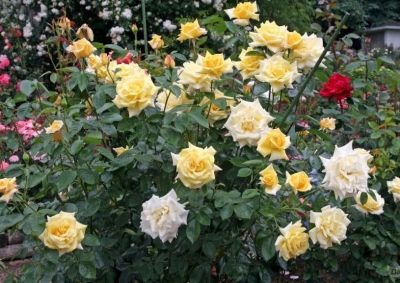
- Authors: Kordes
- Name synonyms: Berolina
- Breeding year: 1984
- Group: tea-hybrid
- The main color of the flower: yellow
- Flower shape: cupped, high center
- Flower size: large
- Diameter, cm: 10-11
- Flower type by number of petals: medium terry
- Scent: fruity
Rose has long become the queen of flowers, but despite this, there are varieties in her kingdom that attract special attention from gardeners, florists and landscape designers. The list of these includes a very beautiful Berolina rose with a long history, which even a beginner, who is familiar with the intricacies of planting and care, can grow.
Breeding history of the variety
The pink Berolina variety is the brainchild of German breeders, which appeared in 1984. The authorship of the culture belongs to Reimer Cordes, who gave the world many pink varieties. The flower is grown in almost all regions of Russia.
Description of the variety
The Berolina hybrid tea rose is a strong and erect plant. The rose bush is characterized by abundant branching, flexible, long and strong stems with a few sharp thorns, good foliage with medium-sized dark green leaves with a glossy matte surface, as well as a developed rhizome that penetrates deeply into the soil.
In a favorable environment, the bush stretches up to 90-100 cm in height. In the southern regions, sometimes shrubs grow up to 2-2.5 meters in height. Due to the moderate growth of lateral shoots, the shrubs are compact - up to 50 cm in diameter. Up to 5 large flowers are formed on the stems.
Advantages and disadvantages
The German rose attracts gardeners not only by its appearance, but also by other numerous advantages: high frost resistance, excellent rain tolerance, in which the rose petals do not stick together, abundant and long flowering, pronounced aroma, as well as good immunity that protects against many viral infections. Among the disadvantages of the culture, it is worth highlighting the average drought resistance, as well as susceptibility to the sun, in which the petals burn out.
Flowering features
Rosa Berolina is famous for its abundant flowering. The period of bud formation and blooming of flowers falls on June-September. It is characteristic that roses bloom in waves, which allows you to enjoy their beauty almost continuously for 4 months. Tall buds, reminiscent of a sharp glass, firmly fixed on the branches, are painted in a light yellow color.
Having blossomed, a semi-double cup-shaped rose is characterized by a dense structure consisting of 30-35 evenly distributed petals. A large flower attracts attention with a graceful shape and volume - a diameter of 10-11 cm. The color of a rose is very defiant - lemon yellow, sometimes it is diluted with a reddish tint.
Use in landscape design
This type of roses is suitable for single plantings and for group plantings. They are usually planted in flower beds, in front gardens, in small rose gardens. In addition, the variety is ideal for cut cultivation, as the flowers retain their freshness and aroma for a long time. Due to its visual appeal and long-term preservation of freshness, the amber-yellow pink variety is very much appreciated by florists.
Landing
The flower is planted in spring - from late March to mid-May, and autumn plantings are also possible from late August to mid-October. In the fall, flowers are planted in the southern regions. For planting, choose a leveled area, protected from wind and drafts. The optimal site will be a place with warmth and light, where there is no constant scorching sun, from which the flower petals fade.It is also worth considering the flow of groundwater, which must be deep.
It is comfortable to grow bushes on fluffy, light, fertile, organic-enriched soils. In addition, the soil must have a good drainage system and a low acidity index. As a rule, these are light loams.
Growing and care
Before planting, pits 30-50 cm deep are prepared, where gravel drainage and a layer of fertilizers mixed with garden soil are laid. The distance between plantings should be at least 50-60 cm, sometimes one meter is required. After planting, the seedlings are watered abundantly with warm water, and the soil is tamped.
Plant care includes: watering with settled water, loosening and weeding the soil, applying top dressing, sanitary pruning of bushes, preventing fungal infections, shelter for the winter. In addition, a garter is sometimes required for mature bushes.
Watering and feeding
Watering the rose bushes is recommended every week, and twice as often during dry periods. For irrigation, standing or warm water is required. Top dressing is applied twice during the growing season - nitrogen-containing mixtures are required in early spring, and phosphorus-potassium mixtures during the summer. It must be remembered that nitrogen fertilizers are applied from the third year of the shrub's life.
Pruning
Pruning is carried out three times. Frozen shoots are removed in the spring, and branches are shortened. In autumn, sanitary pruning is carried out, if necessary, thinning of the bushes. During the summer, wilted buds are removed.
Frost resistance and preparation for winter
Despite their frost resistance, rose bushes need insulation for the winter. In the southern region, there is enough hilling and mulching. In regions with harsh winters, rose bushes are pruned and covered with burlap or agrofibre.
Diseases and pests
Strong immunity provides protection against fungal diseases. If agricultural technology is violated, flowers can get sick with rust, powdery mildew, black spot, cercospora and viral wilting. In addition, the bushes are sometimes attacked by sawflies, leaf rollers, aphids and penny bibs.































































